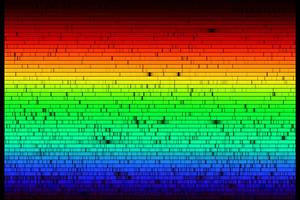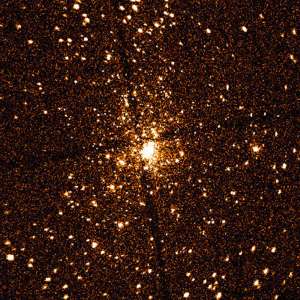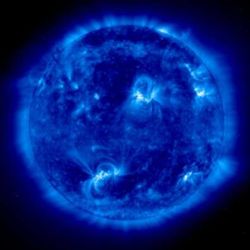Stars and their environment
Studies of stars rely on observations of their spectra. These show that the layers apparent in the optical part of the spectrum (known as the photosphere) have continuous radiation that on the whole can be described by a radiation temperature. The temperatures of most stellar photospheres range between ~ 30,000 K and ~ 2500 K. Absorption lines from abundant elements are also apparent; the strength of these lines depends on the temperature in the photosphere and on the stellar surface gravity.
 |
| High resolution spectrum of the Sun at optical wavelengths. The many dark bands are due to absorption by abundant elements in the solar
atmosphere. Nigel Sharp, NOAO/NSO/Kitt Peak FTS/AURA/NSF |
The adjacent figure shows the solar optical spectrum. Early studies showed that when stellar luminosities and temperatures are plotted against each other (to give what is known as the Hertzsprung-Russell, or HR diagram), only parts of the diagram are occupied. Theories of stellar structure and evolution were developed that account for this behaviour. When stars are young they obtain their energy from nuclear reactions in their cores, transmuting hydrogen to helium in reactions that depend on the core temperatures. Stars in this stage of evolution are said to be on the main-sequence, which appears as a well defined band across the HR diagram. The hottest stars are the most massive, and vice-versa. The more massive stars burn hydrogen more rapidly than do the less massive ones and so they evolve more rapidly. The structure of the star changes and it evolves off the main-sequence to become a sub-giant and then a giant star. Eventually, nuclear reactions involving helium occur in the core; the way in which this occurs and the resulting changes in the stellar structure depend on the initial stellar mass. In later stages of evolution the helium in the core becomes depleted and is replaced with elements such as carbon, nitrogen and oxygen and stars evolve to become supergiants.
Stars cannot be studied in isolation from their environment in a galaxy; nor can galaxies be studied without understanding stars and their life-cycles. The most obvious examples of the interaction of stars and their environment are star formation, mass-loss from evolved stars and mass ejection in supernovae. Star formation occurs in dense molecular clouds, and several stages are passed through before the core of the protostar is sufficiently hot and dense for nuclear reactions to begin. Very young stars are best studied in the infrared part of the spectrum, since at other wavelengths they are obscured by circumstellar material. At later stages, pre-main-sequence stars are known to have accretion discs and jets of material perpendicular to these discs. Young stars also emit in the ultraviolet and X-ray regions of the spectrum, indicating the presence of gas up to millions of degrees.
The righthand figure shows a star forming region in the Orion constellation, as observed with the Chandra X-ray satellite. The physics controlling these strutures and their emission is the topic of current research. There is also considerable interest in brown dwarfs, which are objects that do not have sufficient mass to become stars sustained by nuclear reactions, but which can also show X-ray emission.
Supernovae occur when the interior of a star cannot evolve stably to changes in its structure as nuclear reactions proceed to advanced stages. They return heavy elements to the interstellar medium, and emit blast waves and high levels of radiation which interact with the surrounding regions, thus affecting future star formation.
A wide variety of stars lose mass during their lifetimes; in the more extreme examples this affects their evolution. In hot stars (spectral types O and B) the strong radiation field exerts an outwards pressure that leads to high velocity (~ 103 km/s) winds and a large mass-loss rate. In cool stars (spectral types G, K and M) the physics underlying mass-loss is related to the processes which heat the outer layers (see below). Mass-loss from the Sun (the solar wind) is a result of the high kinetic temperature (~ 106 K) in the corona and the influence of wave motions, but the mass-loss rate is relatively small. In cool giant stars the mass-loss rate is largest for the evolved stars with the lowest surface gravities. These stars do not appear to have hot coronae, although heated regions exist above their photospheres. The pressure associated with waves passing through the atmosphere is thought to contribute to the mass-loss. These stars have low velocity winds and moderate mass-loss rates which when summed over a large number of stars give a significant contribution to the return of material to the interstellar medium. In very cool supergiants, stellar pulsations, waves and radiation pressure on dust grains which form around these stars, can drive substantial mass-loss.
Stellar heating
Main-sequence stars with photospheric temperatures below about 7000 K have a nuclear burning core, surrounded by an inner shell where the energy is carried outwards by radiation and an outer shell where the energy is carried by convective motions. (Convection sets in when the local temperature gradient exceeds the adiabatic gradient.) In F-type stars the convective region is narrow in extent, but in the Sun (early type-G) it occupies about a third of the solar radius, and M-type stars have even thicker convective regions. All stars are rotating, but not as solid bodies; the rotation rate can vary with latitude and depth in the atmosphere. At the base of the convection zone, the stellar rotation rate varies rapidly as the radiative zone is approached. The shear in velocity, plus convection, leads to dynamo action, in which initially weak magnetic fields are amplified. Strong toroidal magnetic flux-tubes are formed, which can rise to the photosphere through magnetic buoyancy. In the Sun, sunspots are thought to be associated with such fields. When the magnetic fields became very large and twisted they can reconnect on themselves to form a poloidal field, with a direction opposite to that of the initial field. In the Sun, this process takes about 11 years, and is called the solar activity cycle. Such cycles are observed in other main-sequence stars. When the solar toroidal fields are large, parts of the flux tubes are observed above the photosphere in the form of magnetic loop structures, which are called active regions. Strong magnetic fields are also observed in the Sun in regions associated with the boundaries of large convective cells (the supergranulation network).
The magnetic fields are responsible for the presence of the hot outer atmospheres which exist above the photospheres of cool stars. Above the photosphere (which in the Sun has a black-body temperature of ~ 5800 K), the kinetic temperature increases with height through the chromosphere (where it reaches ~ 104 K), through the transition region and into the corona, where it reaches Te > 106 K. Even higher temperatures are reached in active region loops (which are illustrated below) and in rapid outbursts of energy called solar flares. The heating of these regions is thought to be by the release of magnetic energy through the dissipation of wave motions and by magnetic field reconnection.


